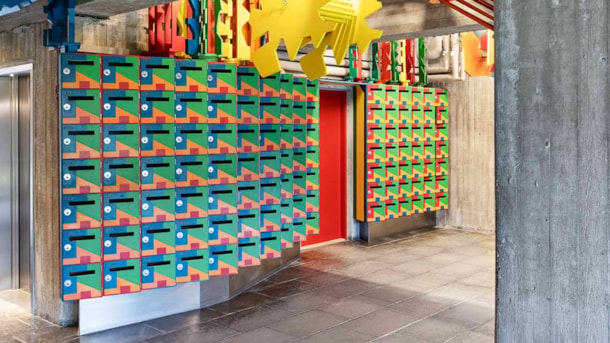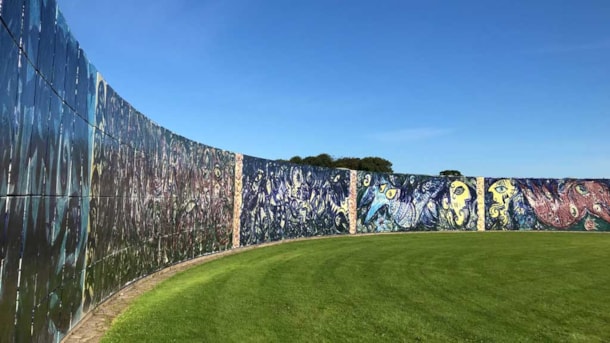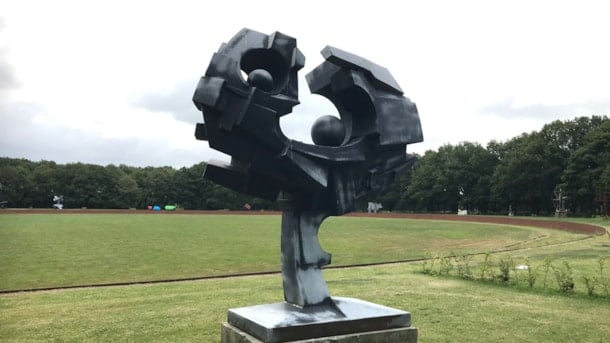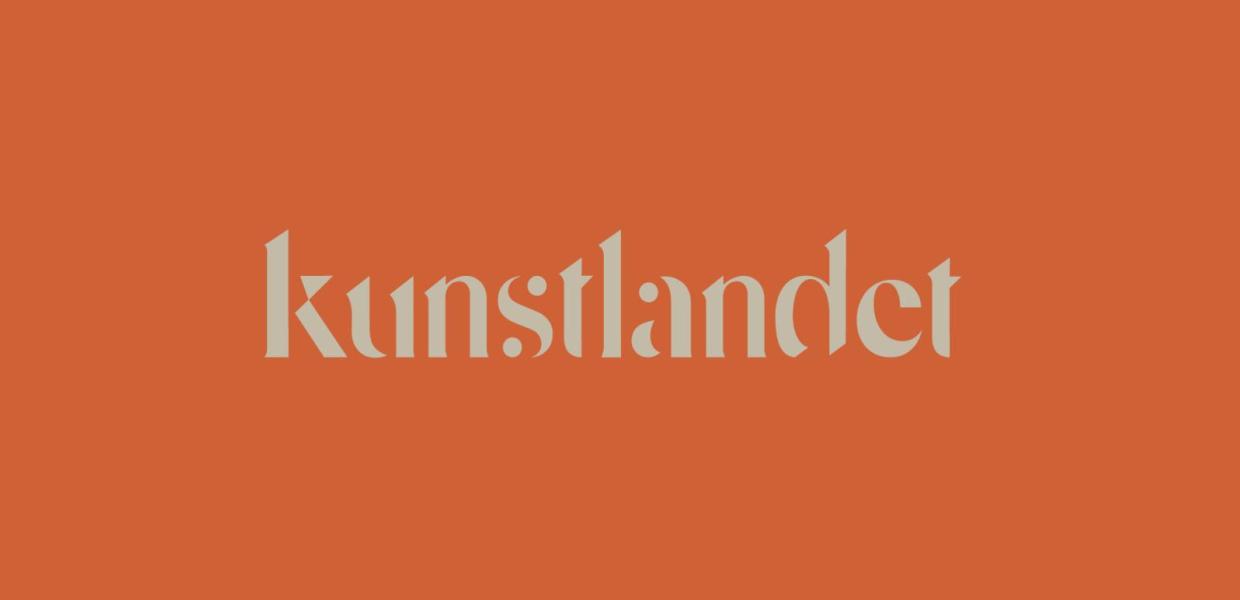The exhibition building "The crooked house" by architects Jan and Karen Eggen and Gunnar Aagaard Andersen (1957)
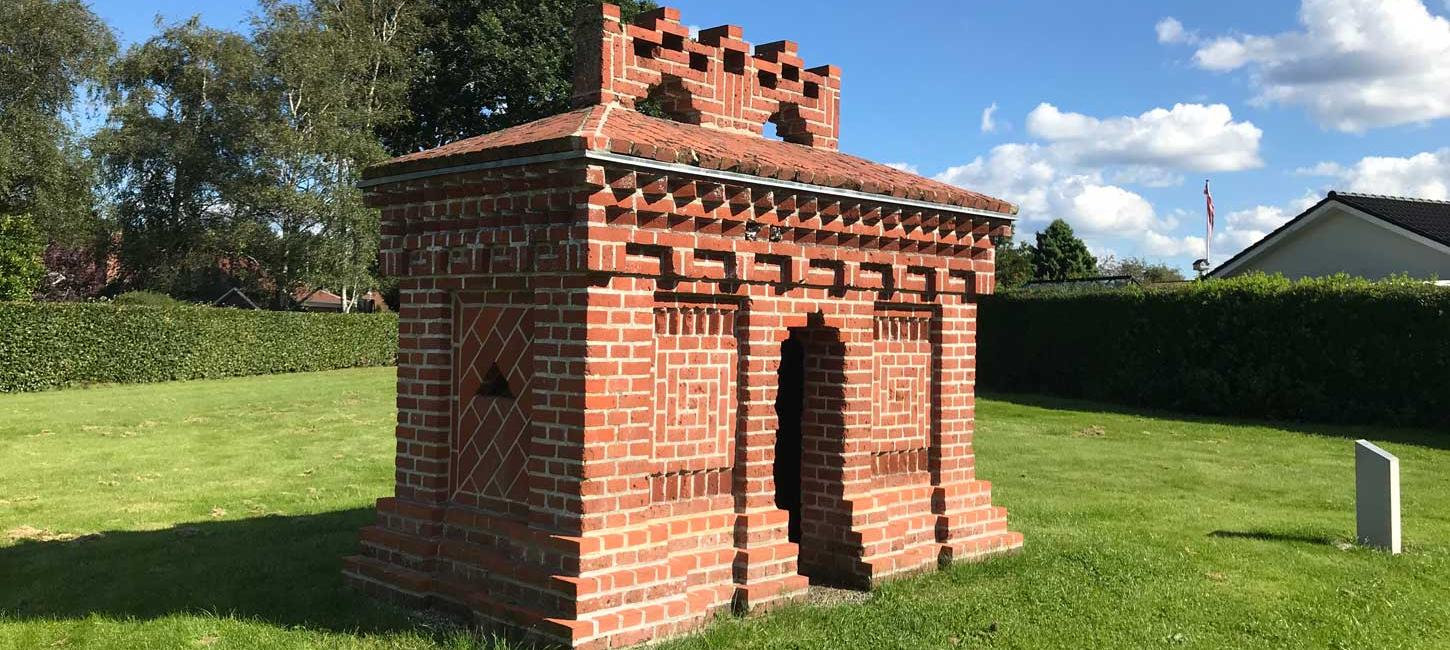
The first works
Art must reach the people.
If you’re inspired to go out and see some of the early artworks created and installed in the area around Herning, Ikast, and Brande, then follow this route. It will take you from hosiers, COBRA, and South America to up among the clouds and birds. Read the full story at the bottom of the page.
Paul Gadegaard in Højhuset
Herning Højskole houses one of the most remarkable examples of total decoration in Danish art history. When the school was built in 1962, artist Paul Gadegaard was invited to create a comprehensive ar...
Egeparken - Skulpturparken i Birk (The Sculpture Park)
The Sculpture Park was planned by the landscape gardener C. Th. Sørensen, which is one of the leading landscape gardeners in Denmark. There is a bust of him at the intrance to the Geometrical Gardens....
Huset i Ikast (The House in Ikast)
The sculpture "The House in Ikast" by Per Kirkeby on Per Kirkebys Vej (1973)
Behind Kunstlandet and Its History
By Kurt H. Jørgensen
A meeting between an artist and a manufacturer at a furniture fair in Copenhagen set in motion the development that would go on to shape an artistic and cultural evolution in central Jutland, centered around Herning.
The year is 1952, and shirt manufacturer Aage Damgaard invites artist Paul Gadegaard to decorate his factory. At the time, staff canteens were uncommon, but Damgaard believed that seamstresses and other employees should have a break away from their machines during lunch.
Gadegaard created a series of abstract and color-rich paintings, placed a grand piano in the corner, installed a sound system, and played jazz over the speakers. This was unheard of in Herning at the time, and the canteen became a public attraction.
The modern textile industry that emerged after World War II, turning the area around Herning, Ikast, and Brande into "Denmark’s Manchester," was rooted in an old tradition where poor farmers on the heath supplemented their income by processing wool from sheep. Nothing was handed to them here. The state did not provide jobs or grants. People created things themselves, often in defiance of the circumstances.
In this Mid Jutland reality and self-image—characterized by a certain rebellion against the capital and centralization—an interest in art took root, and artists found a playground like no other. When the Carl-Henning Pedersen & Else Alfelts Museum opened in 1976, even the national press had to admit that art had moved west, and artist Robert Jacobsen remarked that, artistically speaking, there was more room to breathe in Herning than in Copenhagen.
Between the first canteen and the museum’s opening, Paul Gadegaard continued his collaboration with Aage Damgaard at his next factory, dubbed “The Black Factory.” It was a complete artistic transformation of a traditional textile factory and stands as the strongest example of a gesamtkunstwerk of its time—a total fusion of art, architecture, and interior design. Again, based on Aage Damgaard’s idea that art should not be confined to museums—it should be present in workplaces and public spaces.
This spirit of initiative and vision was contagious. Aage Damgaard’s brother, Mads Eg Damgaard, teamed up with artist Gunnar Aagaard Andersen and architects Jan and Karen Eggen to create “The Crooked House,” a radically different office and showroom for a carpet factory in Herning. In Brande, an art association invited eight artists to the town in 1968, resulting in 23 public works created over one summer. Brande has since become known as the town of mural paintings. In Ikast, a private residential development took an unconventional turn by naming streets after living artists—highly unusual at the time. In exchange for the street name and a modest fee, artists agreed to create unique works for installation in the area. That’s why Bjørn Nørgaard’s first sculpture and Per Kirkeby’s first brick artwork can be found in Ikast.
In 1961–62, the three Damgaard brothers built Herning Folk High School as Denmark’s first and only high-rise folk high school. The building stood out in the flat Mid Jutland landscape and marked the early beginning of the Birk district, which today is home to the HEART museum, the Carl-Henning Pedersen & Else Alfelts Museum, Ingvar Cronhammar’s monumental sculpture Elia, Angligården featuring Carl-Henning Pedersen’s 1,000-square-meter ceramic work The Play of Imagination on the Wheel of Life, Utzon House, and landscape architect C. Th. Sørensen’s masterpieces The Geometric Gardens and The Sculpture Park. The folk high school is now transformed into Højhuset Culture Hotel.
The Birk district’s fusion of art and culture, educational institutions, and businesses has also fostered collaborations with architects and landscape architects such as C.F. Møller, C. Th. Sørensen, Henning Larsen, Torben Schønherr, Tyge Arnfred, Viggo Møller-Jensen, Sven-Ingvar Andersson, Steven Holl, Steen Høyer, and Jørn and Jan Utzon, among others.
The Italian artist Piero Manzoni was drawn to Herning’s experimental environment and left behind many works. Among them is Socle du Monde—the base of the world—upon which the entire world and all of us are turned into one great artwork. Naturally, that base stands in Herning.


